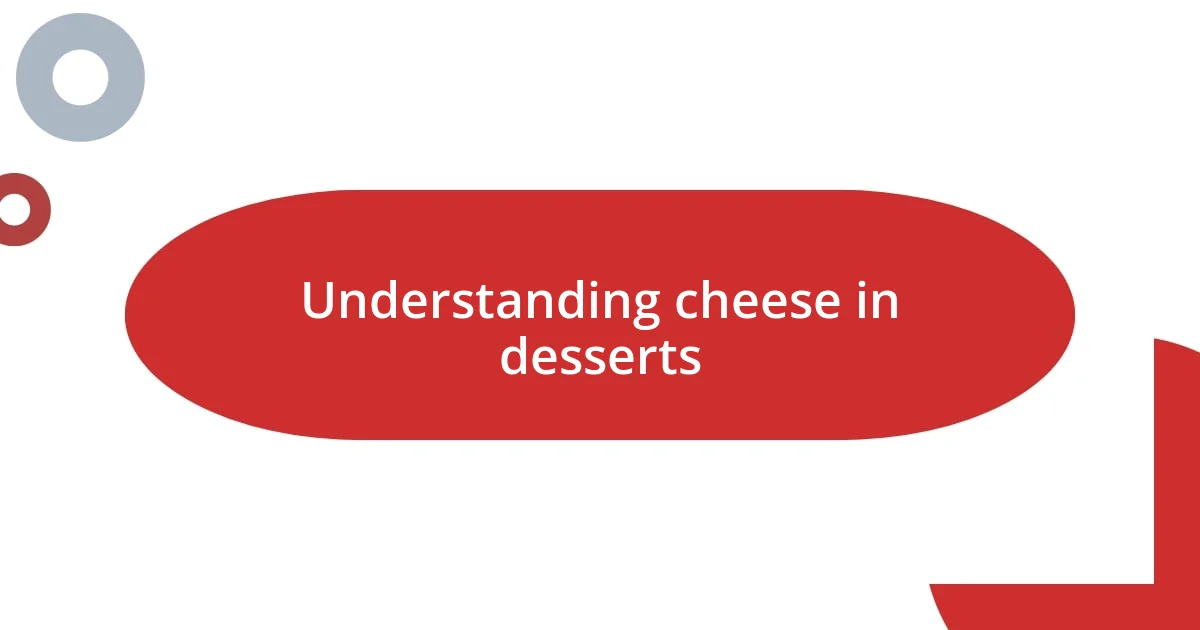Key takeaways:
- Cheese adds unique flavors and textures to desserts, with options like mascarpone, cream cheese, ricotta, goat cheese, and blue cheese enhancing various recipes.
- Creative techniques for incorporating cheese include blending it into batters, using it as fillings or toppings, and adding it to sauces or glazes for unexpected flavor combinations.
- Successful cheese desserts require careful selection of cheese, balancing sweetness, and ensuring ingredients are at the right temperature for optimal results.

Understanding cheese in desserts
Cheese in desserts can feel like an unexpected twist, but trust me, it’s a delightful journey. I remember the first time I tasted a cheesecake that incorporated ricotta—it was creamy and light, with a hint of tanginess that danced beautifully with the sweetness. It made me wonder: why don’t we see more cheeses featured in desserts?
When I experiment with desserts, I often find myself reaching for cream cheese or mascarpone. These cheeses add a luxurious texture that elevates simple recipes into something special. The combination of sweetness and the rich, savory notes of cheese can create complex flavor profiles that are truly unforgettable.
Have you ever tried a dish where cheese and fruit come together? Picture this: a slice of grilled peaches dolloped with goat cheese. The sweet and savory marriage is not just delicious, it’s a flavor surprise that sparks joy. It’s moments like these that remind me why cheese deserves a prominent place in the dessert world.

Types of cheese for desserts
When it comes to choosing the right cheese for desserts, there’s a diverse selection to explore, each with its unique charm. Personally, I find that fresh cheeses often shine in sweet recipes. Their lightness brings a delightful contrast to richer components. For example, I remember making a lemon ricotta cake; the ricotta imparted a subtle sweetness and creaminess that elevated the entire dish.
Here’s a quick list of some fantastic cheeses to consider for your dessert creations:
- Mascarpone: This Italian cheese is silky and rich, perfect for tiramisu or mousse.
- Cream Cheese: Ideal for cheesecakes and frosting, it adds a tangy flavor and smooth texture.
- Ricotta: Great for cakes and pastries, especially when flavored with citrus or vanilla.
- Goat Cheese: It offers a unique tanginess that pairs wonderfully with fruits and honey in tarts.
- Blue Cheese: A bold choice for striking savory-sweet combinations, especially with dark chocolate or pears.

Sweet cheese recipes to try
When it comes to sweet cheese recipes, some classics have a well-deserved reputation that you can’t overlook. Take cannoli, for instance—crisp pastry shells filled with a luscious mixture of ricotta and chocolate chips. The first time I made these, I was amazed at how the creamy filling countered the crunch of the shell. It’s such a celebration of textures that truly showcases the magic of cheese in desserts!
I also enjoy creating my own twist on traditional cheesecake. Using mascarpone instead of cream cheese produces a lighter, more decadent result. One evening, I hosted a small gathering and served mini cheesecakes topped with seasonal fruits. The guests were delighted, and I felt a surge of pride seeing them savor every bite. A dish like this can leave lasting memories, don’t you think?
Lastly, don’t forget about the impressive charm of cheese boards for dessert! You can craft an indulgent platter with sweet cream cheese blends, fruits, and drizzles of honey. I remember one of my favorite evenings was spent sharing this delightful creation with friends over wine. Sharing food like this ignites conversation and laughter, bringing people closer together through flavors.
| Recipe | Main Cheese |
|---|---|
| Cannoli | Ricotta |
| Mini Cheesecakes | Mascarpone |
| Savory-Sweet Cheese Board | Cream Cheese |

Pairing cheese with fruits
When pairing cheese with fruits, I often find that the right combination can elevate any dessert to a whole new level. For instance, during a summer picnic, I brought along a simple platter of fresh figs and creamy goat cheese drizzled with honey. The sweet, earthy taste of the figs perfectly complemented the tanginess of the cheese, creating a harmony that left my friends raving about it for days. Isn’t it amazing how such straightforward ingredients can spark joy?
Adding a splash of acidity can also enhance the flavor profile. I remember experimenting with strawberries and brie on a whim. The buttery richness of the brie balanced the tartness of the berries beautifully. Not only did it taste delightful, but it also looked stunning on the plate. I couldn’t help but snap a photo—it was a moment that felt as good as it tasted.
For a more adventurous approach, I sometimes mix baked apples with sharp cheddar. The warmth of the apples combined with the cheese’s savory edge creates a cozy, comforting dessert that feels like a hug on a plate. I served this at a gathering recently, and I could see the surprise on everyone’s faces; who knew cheese could take something so familiar as baked apples and make them extraordinary? What flavor pairings have surprised you in dessert-making?

Techniques for incorporating cheese
When I incorporate cheese into desserts, one technique I love is blending it directly into batters or creams. For example, I recently made a chocolate cake using cream cheese in the batter, which added a moist richness that was simply divine. It’s amazing how a simple twist can elevate a familiar dessert, isn’t it?
Another technique I often utilize is using cheese as a filling or topping. I recall making some rich, stuffed French toast, filled with sweet ricotta and vanilla. As it cooked, the filling became beautifully creamy, complementing the crisp exterior and creating a delightful contrast—trust me, it was heavenly. Can you imagine the anticipation as that first bite melted in your mouth?
Finally, incorporating cheese into sauces or glazes can transform the entire dish. I remember making a cheesecake with a tangy lemon glaze that had a hint of goat cheese. The unexpected pairing of flavors was a revelation, bridging sweetness and a savory note that danced across the palate. Have you tried experimenting with cheese in glazes? It’s a fantastic way to add depth to your desserts!

Creative dessert presentations
When it comes to creative dessert presentations, I love to play with textures and colors. A recent favorite of mine was a deconstructed cheesecake served in a mason jar. I layered creamy cheesecake with a tart berry compote and topped it with crushed graham crackers for crunch. The different layers looked so appealing, and it sparked curiosity—everyone wanted to know how I put it together!
I also enjoy using unexpected vessels for serving desserts. At a dinner party, I served mini lemon cheesecake bites in antique teacups, which added a charming touch. Guests were charmed by the vintage look, and the personal flair encouraged lively conversation. Have you ever considered how the way you present a dessert can set the tone for the entire dining experience?
Another trick I use is garnishing with herbs or edible flowers. Recently, I whipped up a ricotta-and-honey panna cotta and topped it with a sprig of mint and a lavender flower. It not only tasted heavenly but looked stunning too. The addition of fresh elements brought a vibrant contrast to the creamy dessert, making it as delightful to the eye as it was to the palate. Have you explored garnishing beyond the usual options? You might be surprised by the creative avenues that open up!

Tips for successful cheese desserts
One vital tip for making cheese desserts successful is to choose the right type of cheese for your dish. For example, I once made a mascarpone mousse that was incredibly light and airy, a perfect match for summer berries. Have you ever considered how the creaminess of mascarpone can change the texture of a dessert? It’s all about harmonizing flavors!
Balancing sweetness is another essential factor. I recall a lemon ricotta cake that I baked—while the ricotta brought a delicate richness, I found that adding a touch of extra sweetness helped to highlight its tanginess. It’s surprising how a little adjustment can elevate a dish from good to unforgettable, isn’t it? Adjusting sugar levels can be a game-changer in achieving that delightful balance.
Lastly, don’t forget about the temperature of your ingredients. For instance, I’ve learned that using room-temperature cream cheese when making frosting results in a silky texture that spreads like a dream. If you take a minute to bring your cheeses to the proper temperature, it can make all the difference in both flavor and consistency. How often do you think about the temperature of your ingredients while baking? Trust me, it can transform the final result!













